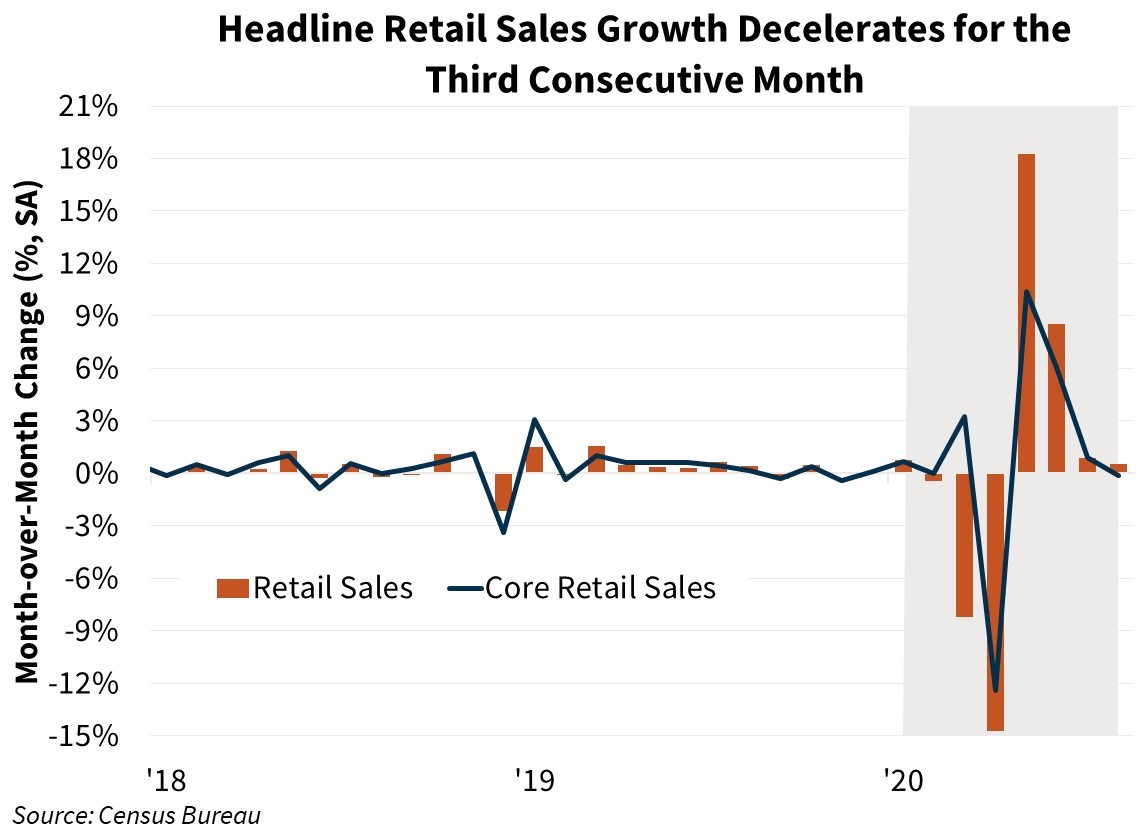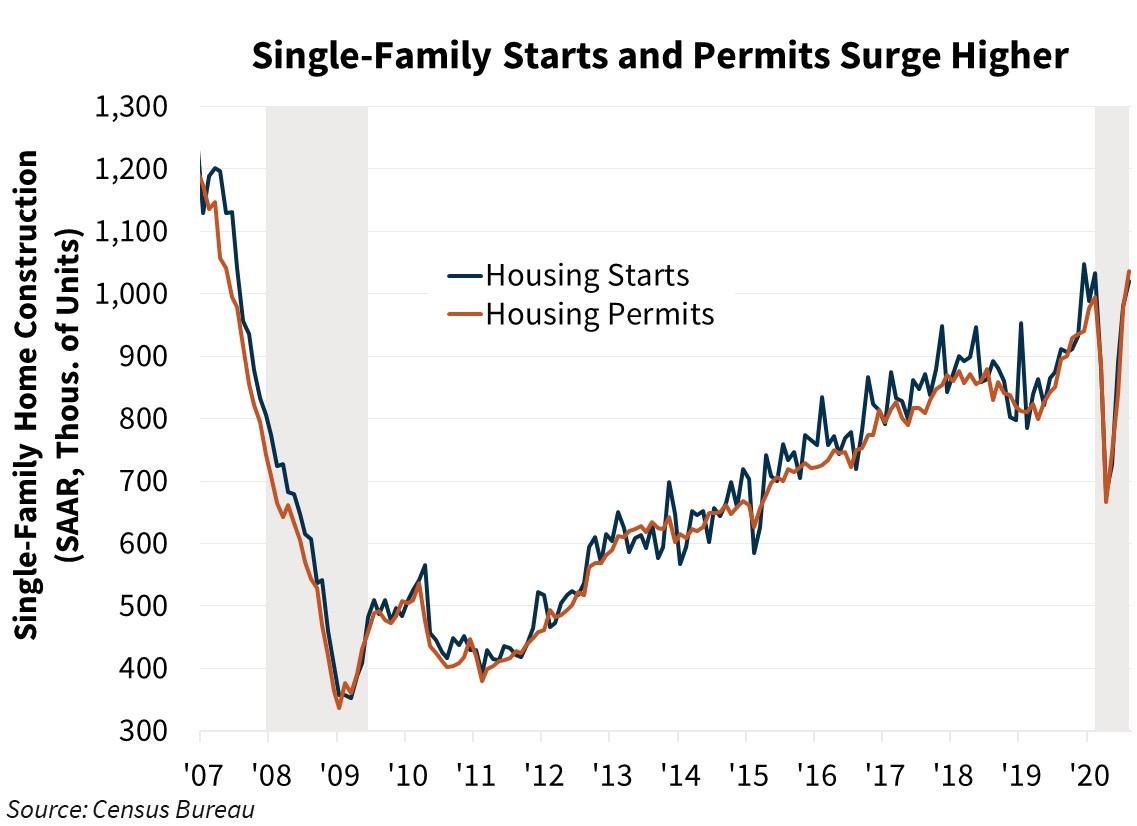Single-Family Housing Starts and Permits Both Climb to Over One Million Units
Key Takeaways:
- As expected, the Federal Open Market Committee (FOMC) left the federal funds rate unchanged at its September meeting and reiterated that asset purchases would continue at the current pace of at least $80 billion a month in Treasuries and $40 billion a month in MBS. While the FOMC reinforced that it “will aim to achieve inflation moderately above 2 percent for some time” to reach its now long-run average goal of 2 percent, the time period over which inflation would be averaged was left unclear.
- Retail sales rose 0.6 percent in August, a deceleration from the prior three months, according to the Census Bureau. Core retail sales, which exclude auto, building material, and gas station sales, edged down one-tenth. The rebound seen in May and June has slowed and, for the first time in three months, no sectors posted double-digit growth. Details of the report suggested that COVID-19 concerns might be easing as restaurant sales posted one of the strongest month-over-month increases of any sector, though it remained 15.4 percent below year-ago levels.
- Industrial production, a gauge of output in the manufacturing, utility, and mining sectors, rose 0.4 percent in August, according to the Federal Reserve Board. The gain was driven entirely by manufacturing output, which increased 1.0 percent, while mining and utility output fell 2.5 percent and 0.4 percent, respectively.
- The University of Michigan Consumer Sentiment Index increased 4.8 points to 78.9 in the September preliminary reading. While this represents the highest reading since March, it remained 22.1 points below February’s recent peak.
- Housing starts declined 5.1 percent in August to 1.42 million annualized units, according to the Census Bureau. The decline was driven by multifamily starts, which fell 22.7 percent, a pullback from July’s robust increase. Multifamily permits also posted a double-digit decline. Single-family starts, however, rose 4.1 percent to 1.02 million, which represents a nearly full recovery to February’s 1.03 million annualized pace. Single-family permits rose to 1.04 million, breaking past a million units for the first time since 2007. On a year-to-date basis, total starts were 5.2 percent above the same period a year ago.
- The National Association of Home Builders/Wells Fargo Housing Market Index jumped 5 points in September to 83, a record high in the series’ 35-year history. The three subcomponents: present sales, the sales outlook over the next six months, and the index for the traffic of prospective buyers, increased to record highs as well.
Forecast Impact:
The Fed reemphasized its average 2 percent objective at its September meeting this week, but given stubbornly low inflation over the past decade, we remain skeptical about the effectiveness of the Fed’s shift in policy. The skepticism appeared to percolate even the FOMC as, in the September Economic Projections, members’ median projections for inflation do not reach 2 percent until 2023. Slowing retail sales growth in August is further evidence that the strong economic recovery observed early this summer has likely tempered. The deceleration may be in part due to the expiration of the $600 weekly unemployment subsidy, which expired at the end of July. With the prospect of additional stimulus uncertain, we believe a pullback in consumer spending remains a key downside risk for the fourth quarter. Similarly, industrial production growth decelerated for the second straight month in August. Manufacturing output grew and the sharp drop in mining output was likely temporary as Tropical Storm Marco and Hurricane Laura caused disruptions to oil drilling and gas extraction operations. Housing continues to be the bright spot of the economy. Single-family starts have almost completely recovered back to pre-pandemic levels and, given the robust pace of permits and record-high homebuilder sentiment, we expect will likely continue at a strong rate in the fourth quarter. While the increase in single-family starts was in line with our expectations, we believe upward revisions to the prior two months will likely mean yet another upward revision to our near-term starts forecast.


Economic and Strategic Research Group
September 18, 2020
Opinions, analyses, estimates, forecasts and other views of Fannie Mae's Economic and Strategic Research (ESR) Group included in these materials should not be construed as indicating Fannie Mae's business prospects or expected results, are based on a number of assumptions, and are subject to change without notice. How this information affects Fannie Mae will depend on many factors. Although the ESR group bases its opinions, analyses, estimates, forecasts and other views on information it considers reliable, it does not guarantee that the information provided in these materials is accurate, current or suitable for any particular purpose. Changes in the assumptions or the information underlying these views, including assumptions about the duration and magnitude of shutdowns and social distancing, could produce materially different results. The analyses, opinions, estimates, forecasts and other views published by the ESR group represent the views of that group as of the date indicated and do not necessarily represent the views of Fannie Mae or its management.
